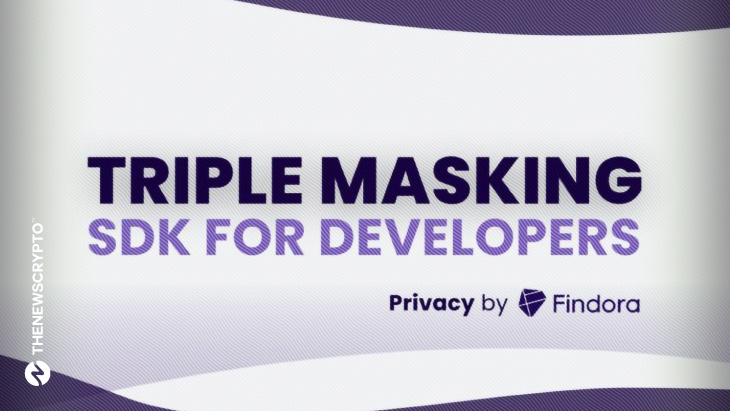Findora, a cutting-edge Layer-1 blockchain that combines auditability and privacy to support regulatory compliance, has announced the release of its Findora Triple Masking SDK, a universal set of privacy-preserving solutions for Web3.
Developers have an easy method to include zero-knowledge proofs into their decentralized applications thanks to the Findora Triple Masking SDK. Users will have a variety of choices for what information is disguised or stays exposed, allowing them to perform private transactions that are yet auditable. It offers any Web3 dApp easy, plug-and-play privacy.
The fundamental issue of how to “own” anything that can be accurately duplicated was resolved by blockchain. How is the “double-spend” issue resolved? The openness that allowed users to track each digital asset’s movement on a decentralized accounting system was essential to this approach. The public had to be able to observe the movement of these assets, even if this technology did away with the requirement for a third party to serve as a trustworthy record keeper. As a consequence, businesses and organizations that were mandated by law to protect the confidentiality of certain pieces of personal information (such health records) were prohibited from using this new technological development.
Over the last 50 years, regulations have been codifying the need for financial institutions to preserve customer privacy. Consumers have a right to privacy when it comes to their private financial information. The rules governing these financial organizations are centered on the need that any sharing of personal identifying information, such as account balances, product purchases, and so forth, must have the consumers’ agreement. Their right, to privacy, has been seen as the users’ only right to decide who may access their data and provide their permission.
By using a cryptographic method called zero-knowledge proofs, blockchains may hide transaction data while still enabling the data contained within to be verified. While computationally challenging, this approach enables a blockchain to confirm the movement of a specific digital asset without the need for sender, recipient, or asset-specific metadata. In other words, they are the crucial component needed to ensure that digital assets are only used once while still enabling private transactions.
“Triple Masking fulfills a promise that blockchain technology made years ago: your financial status, your financial future, is no longer in the hands of some unknown, so-called “trusted” third party. It’s in your hands,” said Sam Harrison, CEO, Discreet Labs. “This SDK simplifies the developer experience of implementing complicated zk-proofs, which in turn enables more decentralized applications to offer the benefits of these zk-proofs to their users.”
Harrison went on, “Users tend to have to make a choice between privacy and convenience. And when they do, they usually pick convenience. I am excited to see what choices developers can offer their users when privacy and convenience are both attainable.”
With comprehensive privacy protection and transaction anonymity instead of just pseudonymity, the Findora Triple Masking SDK is a privacy-focused asset transfer solution supported on the Findora Network. Every developer may make their dApps ZK-enabled using the SDK, with three degrees of configurable transaction privacy. Users may choose to conceal the kind of asset involved, the amount transmitted, and both the sender’s and receiver’s wallet addresses since it is adjustable. Transactions will continue to be auditable at the same time to guarantee regulatory compliance. The asset tracing features included in the Findora Triple Masking SDK enable auditors to track every transaction while hiding it from inquisitive eyes on the open blockchain.
“Triple Masking is more than simply encrypting information. We are also offering the ability to trace assets in a way that complies with existing regulations and analysis tools. This way, Triple Masking solves both the privacy AND compliance requirements of a professional institution,” Harrison added.
Findora Triple Masking, which can grow to thousands of transactions per second, is substantially quicker than the industry standard and is built on application-specific turbo-plonk ZK-circuits. Developers will be able to include masking services in transactions between EVM standard wallets and more privacy-preserving architectures like bitcoin’s unspent transaction output (UTXO) format once compatibility with popular elliptic curve signature algorithms like ed25519 and secp256k1 is added. Additionally, developers will be able to add these privacy-preserving capabilities to any asset type (such as an FRC20, FRC721 or FRC1155) by using Findora’s Prism++ transfer mechanism. Findora is ready to take over as the de facto universal privacy layer for all Web3 thanks to its straightforward software development kit.
“Findora Triple Masking uses application-specific turbo-plonks, a type of zero-knowledge succinct non-interactive argument of knowledge, also known as a zk-Snark. This solution creates an anonymous blind asset record (an “ABAR”) that enables asset transfers to be encrypted as a cryptographic commitment rather than storing transaction data in plaintext like they do on other public ledgers,” said Weikeng Chen, Chief Scientist, Discreet Labs. He went on, “This is similar to the way zcash stores their cryptographic commitments. For most EVM chains, however, the transaction data is stored as plaintext and is therefore open to public scrutiny.”
Due to Findora’s compliance with the secp256k1 curve, popular EVM wallets like MetaMask will be able to sign transactions.
“While MetaMask may not be able to enable private transactions directly,” Harrison said, “the private transactions can be signed by MetaMask and handled by the applications directly.”
Harrison continued, “This is a very significant achievement. The release of this SDK is the culmination of the original design of the founders of Findora. A solution set that provides a user with the choice to retain confidentiality while at the same time providing a mechanism that supports regulatory compliance regarding asset tracing and other applicable laws. It isn’t an exaggeration to say that this solution is what the blockchain industry has been waiting for.”








